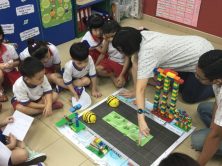
In this post, we will return to the topic of Singapore math and analyze the curriculum. We will describe the three teaching principles used and the three learning phases that occur in their classrooms.
Teaching Principles of Singapore Math
Teaching is for learning, learning is for comprehension, comprehension is for reasoning, application, and finally, to problem solve.
In Singapore, learning mathematics centers on comprehension. Through comprehension focused learning, students are able to more easily recall the procedures taught. Furthermore, if students learn with comprehension as the main focus they will be able to reason and apply mathematics to solve problems which is the primary goal within the mathematics curriculum in Singapore.
Teaching should be based on student knowledge, knowing their interests, experiences, and engaging them in active and reflexive learning.
Mathematics is a hierarchal subject and without comprehension, previous knowledge becomes superficial. It is important for teachers to verify that students understand before moving on to new concepts and skills.
Furthermore, teachers should be conscious of their student’s interests so that they can develop stimulating and challenging learning tasks.
Teaching should connect learning with the real world, taking advantage of ICT tools and emphasizing competencies of the 21st century.
There are many ways to apply mathematics in the real world. If students understand these applications they will see the significance and relevance of math.
ICT tools, like Smartick, help students understand mathematical concepts through simulations and representations.
Learning Phases
Effective instruction of a unit generally involves 3 phases of learning: Preparation, Commitment, and Mastery.
Phase 1: Preparation
Preparing students to learn is vital to the success of learning.
- Previous knowledge: In order for students to be ready to learn, teachers need to check that they have the concepts and skills necessary for the new topic.
- Motivating context: Teachers should provide motivating and meaningful context for the student.
- Learning environment: Classroom rules should help promote respectful and emotionally safe interactions among students.
Phase 2: Commitment
This is the main phase of learning. In this phase, teachers involve the students in learning new concepts and skills. These 3 pedagogical approaches are used in Singapore:
- Activity-based learning: Students must learn by doing. This approach is particularly effective to teach mathematical concepts and skills to primary and secondary levels, but it also effective with higher levels. Through manipulation and concrete experiences, students discover a concept or an abstract mathematical result.
- Teacher directed investigation: Students must learn through guided research. In place of giving answers, teachers invite students to explore, research, and find answers on their own. Students learn to ask questions, process information, communicate, explain, and reflect on their responses. This improves the development of mathematical processes and competencies of the 21st century.
- Direct Instruction: This approach consists of teachers telling students what they will learn and what they are expected to do, in turn helping students center on the unit objectives.
Phase 3: Mastery
This is the final phase of learning in which teachers help students consolidate and expand their learning using these three resources:
- Practice: The students need practice to master concepts. Practice should include repetition and variation to achieve competency and flexibility.
- Reflective review: It is important that students consolidate and deepen their learning through tasks that allow them to reflect on their learning. This is a good habit which needs to be cultivated from an early age and supports the development of metacognition.
- Extended learning: More capable students should have opportunities to expand their learning. This can be done through more challenging tasks to enhance their understanding of a concept.
References:
- Mathematics Syllabus: Primary One to Five. Ministry of Education, Singapore
- Smartick lands in Singapore, a country with one of the most challenging education systems in the world.
- Foundations of the Singapore Method in Math Instruction
Learn More:
- Singapore: Experiences in Learning
- Singapore: Classroom Assessment
- Singapore: Goals, Objectives, and Design of Its Curriculum
- Theoretical Framework of the Singapore Method
- Singapore: Math Curriculum in Primary Education








I thoroughly enjoyed reading your insightful blog post on the teaching principles of Singapore Math. As an advocate for quality education and a firm believer in the effectiveness of Singapore Math, I couldn’t agree more with the principles and methodologies discussed. , the teaching principles of Singapore Math have proven to be highly effective in nurturing mathematical proficiency, critical thinking skills, and a love for learning. By focusing on foundational understanding, problem-solving, visualization, collaboration, and spiral progression, Singapore Math sets students on a pathway to mathematical success. Kudos to all the educators who embrace these principles and go above and beyond to inspire their students to reach their full potential in the realm of mathematics.
Thank you very much for your comment!